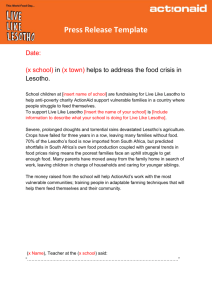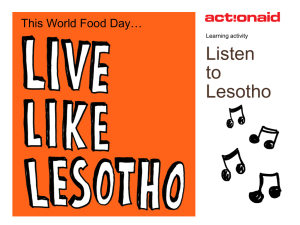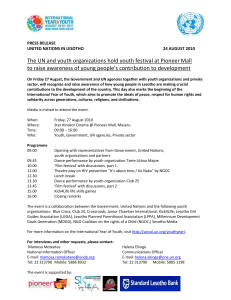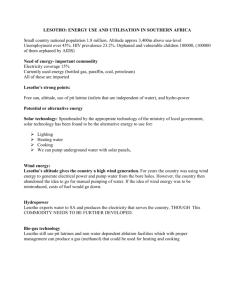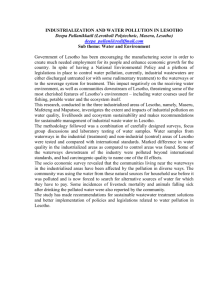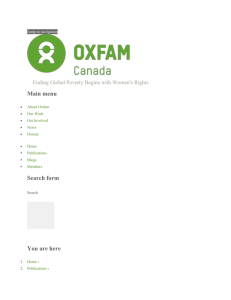Development - Penyrheol Comprehensive School Moodle
advertisement
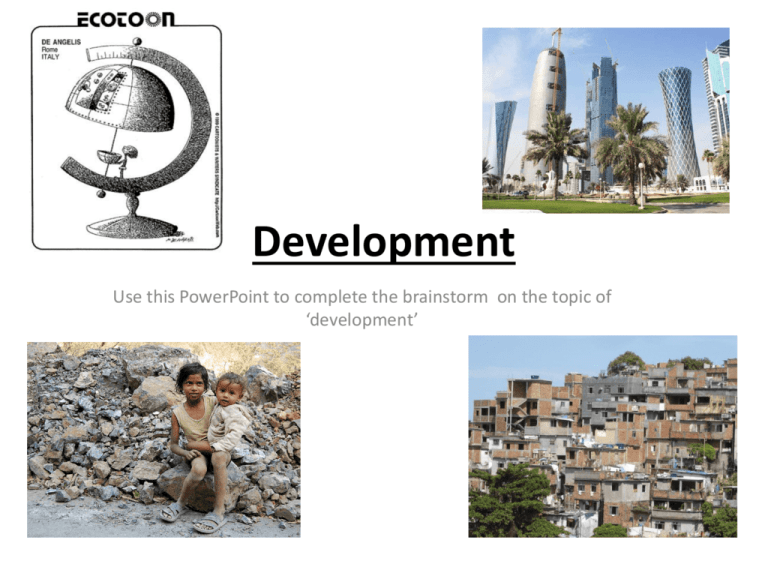
Development Use this PowerPoint to complete the brainstorm on the topic of ‘development’ Key words • Development is the process of change which improves the well being of society in terms of material wealth and quality of life. Countries are in different stages of development • LEDC’s are less economically developed countries • MEDC’s are more economically developed countries • NICs – newly industrialising countries • RICs – recently Industrialised Countries Measures of development • Lots of different ways development can be measured. • Can be spilt into economic (money) and social (people) indicators Video http://www.bbc.co.uk/schools/gcsebitesize/geography/development/contrasts_devel opment_video.shtml Measures of development Global pattern of Development • North/ South divided • Brandt Line – 1980’s divided the world into a rich north and poor south Global pattern of Development This line is know becoming increasingly out of date as more countries are starting to develop Regional patterns of development Case-study Ghana • Ghana is a sub Saharan country • The GNI is $770 per person • It is an LEDC • 45% of the population live on less than $1 a day • 19% of children are malnourished • There is a north south divided within the country • Rich south and poor north Make sure you can do a quick sketch map of Ghana (remember you will only get 1 mark – so do not do a detailed map ) Get the shape right and label the capital city and surrounding countries North South Divide- Facts Facts you can use in the exam to show knowledge of case-studies Regions GNI Access to health care Child malnutrition Greater Accra (south) >300 81% 40.4% Upper east (North) <200 27% 33% Causes of north/south divide South • Has a coastline this has allowed the southern regions to trade easily through shipping ports. • The coast has also attracted tourism to the southern regions. • Has better infrastructure and industry has developed here. North • North has a harsher climate and unreliable rainfall, this means that farming is also unreliable. Millennium Development Goals Videos 1. https://www.youtube.com/w atch?v=Sj6q0Apd_cs 2. https://www.youtube.com/w atch?v=v3p2VLTowAA Progress – South Asian Countries • • • • Progress slower than other regions (apart from Africa) 3% drop in extreme poverty (49% to 39%) A good 11% gain in primary school enrolment Cut in half the proportion of people without access to clean drinking water • Although 580 million people without sanitation • Infant mortality was 7-11% Progress –Sub Saharan Africa • Made the least progress • Number of people hungry has gone down from 32% (1990) to 28% - however this is too slow Aid Video http://www.bbc.co.uk/schools/ gcsebitesize/geography/develo pment/aid_video.shtml Aid Casestudy - Lesotho Highlands Water Project • Large scale scheme to transfer water from Lesotho to South Africa (city of Johannesburg) • Shortage of clean water in Johannesburg (South Africa) • Lesotho is one of the world poorest countries, with no natural resources to sell apart from water • Scheme involved building 200km long system of tunnels and 6 dams • Cost = $8 Billion • Funded by a loan from the world Bank Lesotho is shaded in yellow. It is located within the country of South Africa Lesotho Highlands Water Project Advantages Disadvantages Lesotho • Make money from selling • Resulted in water shortages as water is water to South Africa being piped to South Africa • 75% of the countries • Funded by a loan so has to be paid back income comes from selling with interest this water • Social and environmental impacts in the • The construction work building of the dams created many jobs South Africa • Supplies densely populated areas have access to clean drinking water • Many people had increased water bills before receiving improved water supply • Bills went up to fund the construction • M<much of the water is lost due to leaking pipes Casestudy - Small scale water project – Oxfam, WaterAid and Rural Aid • Access to clean water and sanitation facilities in Ghana is low, particularly in rural areas. • Oxfam, WaterAid and Rural Aid (NGO’s) worked with local communities to construct hand dug wells with pumps • The project involved local people in the constructions • Uses appropriate technology • One village to benefit from the well was Asamponbisi Village Video - http://www.bbc.co.uk/learningzone/clips/finding-and-collecting-water-inafrica/542.html Small scale water project – Oxfam, WaterAid and Rural Aid Advantages Disadvantages • Clean water provided to villages • Project only small scale • Children no longer have to walk • Only benefit the communities miles to the nearest water source where the well has been built (that did not provide clean water) and instead go to school. • Reduced illness that resulted from drinking unclean water • Reduced infant mortality Casestudy - Oxfam Primary education project • 100% of children attend school in MEDCs in LEDC many children are not able to go to school, the main reason for this is poverty. • There has been a particular focus on improving education for girls. This is because: – – – – Girls are less likely to be educated the child of an uneducated mother is twice as likely to die (infant morality G4) Educated women are more likely to have a smaller family (reduces poverty G1) Empowers women (gender equality G3) Oxfam Primary education project • Long term development project • Aims to provide support for primary school to Ghana • Communities here are pastoral farmers – very poor and cant afford to send their children to school • Project supports 48 primary schools • Outcomes: – 4053 enrolled at school (45% of these were girls) – Women involved in the management of school G3 – Ration of books per pupil improved (from 1/5 to 2/3) Large scale project vs Small scale NGO’s in recent times tend to stick to small scale development projects. Even through these only benefits relatively small numbers of people. Small scale projects are generally run by local people and there fore do not have such a great impact on the environment and people living in an area. Small scale project = sustainable
